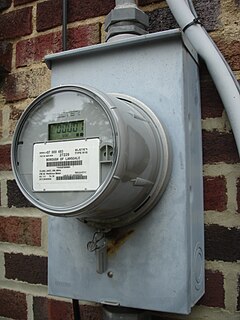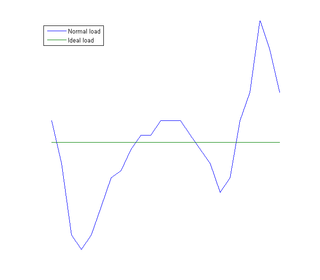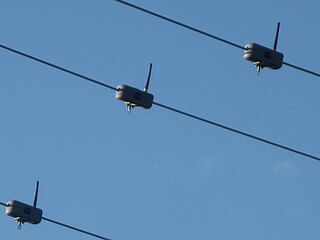Ubiquitous computing is a concept in software engineering, hardware engineering and computer science where computing is made to appear anytime and everywhere. In contrast to desktop computing, ubiquitous computing can occur using any device, in any location, and in any format. A user interacts with the computer, which can exist in many different forms, including laptop computers, tablets, smart phones and terminals in everyday objects such as a refrigerator or a pair of glasses. The underlying technologies to support ubiquitous computing include Internet, advanced middleware, operating system, mobile code, sensors, microprocessors, new I/O and user interfaces, computer networks, mobile protocols, location and positioning, and new materials.

Automatic meter reading (AMR) is the technology of automatically collecting consumption, diagnostic, and status data from water meter or energy metering devices and transferring that data to a central database for billing, troubleshooting, and analyzing. This technology mainly saves utility providers the expense of periodic trips to each physical location to read a meter. Another advantage is that billing can be based on near real-time consumption rather than on estimates based on past or predicted consumption. This timely information coupled with analysis can help both utility providers and customers better control the use and production of electric energy, gas usage, or water consumption.
Datacasting is the broadcasting of data over a wide area via radio waves. It most often refers to supplemental information sent by television stations along with digital terrestrial television, but may also be applied to digital signals on analog TV or radio. It generally does not apply to data which is inherent to the medium, such as PSIP data which defines virtual channels for DTT or direct broadcast satellite systems; or to things like cable modem or satellite modem, which use a completely separate channel for data.
Ambient devices are a type of consumer electronics, characterized by their ability to be perceived at-a-glance, also known as "glanceable". Ambient devices use pre-attentive processing to display information and are aimed at minimizing mental effort. Associated fields include ubiquitous computing and calm technology. The concept is closely related to the Internet of Things.

In computing, ambient intelligence (AmI) refers to electronic environments that are sensitive and responsive to the presence of people. Ambient intelligence was a projection on the future of consumer electronics, telecommunications and computing that was originally developed in the late 1990s by Eli Zelkha and his team at Palo Alto Ventures for the time frame 2010–2020. Ambient intelligence would allow devices to work in concert to support people in carrying out their everyday life activities, tasks and rituals in an intuitive way using information and intelligence that is hidden in the network connecting these devices. As these devices grew smaller, more connected and more integrated into our environment, the technological framework behind them would disappear into our surroundings until only the user interface remains perceivable by users.

Nabaztag is a Wi-Fi enabled ambient electronic device in the shape of a rabbit, invented by Rafi Haladjian and Olivier Mével, and manufactured by the company Violet. Nabaztag was designed to be a "smart object" comparable to those manufactured by Ambient Devices; it can connect to the Internet. It is also customizable and programmable to an extent. Sylvain Huet developed most of the embedded code of all Violet objects. Sebastien Bourdeauducq developed the Wi-Fi driver. Antoine Schmitt has been their behavior designer and Jean-Jacques Birgé their sound designer. Maÿlis Puyfaucher wrote all the original texts pronounced by the rabbit.

A smart meter is an electronic device that records information such as consumption of electric energy, voltage levels, current, and power factor. Smart meters communicate the information to the consumer for greater clarity of consumption behavior, and electricity suppliers for system monitoring and customer billing. Smart meters typically record energy near real-time, and report regularly, short intervals throughout the day. Smart meters enable two-way communication between the meter and the central system. Such an advanced metering infrastructure (AMI) differs from automatic meter reading (AMR) in that it enables two-way communication between the meter and the supplier. Communications from the meter to the network may be wireless, or via fixed wired connections such as power line carrier (PLC). Wireless communication options in common use include cellular communications, Wi-Fi, wireless ad hoc networks over Wi-Fi, wireless mesh networks, low power long-range wireless (LoRa), Wize ZigBee, and Wi-SUN.
FreeWave Technologies, Inc. is an industrial company based in Boulder, Colorado, where it designs and manufactures secure machine-to-machine wireless networking, communications, and computing systems. FreeWave's radios capture and transmit data from devices such as sensors, gauges, valves, robots, drones, and unmanned vehicles over long distances in clear line-of-sight environments and harsh environments. FreeWave radios support a variety of industrial applications, such as supervisory control and data acquisition (SCADA), wireless I/O, cathodic protection (CP) and remote monitoring, telemetry, and analytics. The Company sells to a variety of enterprises such as energy, utilities, agricultural, government and defense, water and wastewater, manufacturing, and commercial enterprises. The Company conducts network design, path studies, and pre-installation engineering services to support its customers.

Sierra Wireless is a Canadian multinational wireless communications equipment designer, manufacturer and services provider headquartered in Richmond, British Columbia, Canada. It also maintains offices and operations in California, Sweden, Korea, Japan, China, Taiwan, France, Australia, New Zealand and Hong Kong.

Load management, also known as demand-side management (DSM), is the process of balancing the supply of electricity on the network with the electrical load by adjusting or controlling the load rather than the power station output. This can be achieved by direct intervention of the utility in real time, by the use of frequency sensitive relays triggering the circuit breakers, by time clocks, or by using special tariffs to influence consumer behavior. Load management allows utilities to reduce demand for electricity during peak usage times, which can, in turn, reduce costs by eliminating the need for peaking power plants. In addition, some peaking power plants can take more than an hour to bring on-line which makes load management even more critical should a plant go off-line unexpectedly for example. Load management can also help reduce harmful emissions, since peaking plants or backup generators are often dirtier and less efficient than base load power plants. New load-management technologies are constantly under development — both by private industry and public entities.
GridPoint is a cleantech company that provides energy management and sustainability services to enterprises and government agencies, such as electric utilities.
EFM32 Gecko MCUs are a family of mixed-signal 32-bit microcontroller integrated circuits from Energy Micro based on ARM Cortex-M CPUs, including the Cortex-M0+, Cortex-M3 and Cortex-M4.
Ember was an American company based in Boston, Massachusetts, USA, which is now owned by Silicon Labs. Ember had a radio development centre in Cambridge, England, and distributors worldwide. It developed ZigBee wireless networking technology that enabled companies involved in energy technologies to help make buildings and homes smarter, consume less energy, and operate more efficiently. The low-power wireless technology can be embedded into a wide variety of devices to be part of a self-organizing mesh network. All Ember products conform to IEEE 802.15.4-2003 standards.

Silicon Laboratories, Inc. is a fabless global technology company that designs and manufactures semiconductors, other silicon devices and software, which it sells to electronics design engineers and manufacturers in Internet of Things (IoT) infrastructure worldwide.

Smart thermostats are Wi-Fi thermostats that can be used with home automation and are responsible for controlling a home's heating, ventilation, and air conditioning. They perform similar functions as a Programmable thermostat as they allow the user to control the temperature of their home throughout the day using a schedule, but also contain additional features, such as sensors and Wi-Fi connectivity, that improve upon the issues with programmable thermostats.

A Wireless powerline sensor hangs from an overhead power line and sends measurements to a data collection system. Because the sensor does not contact anything but a single live conductor, no high-voltage isolation is needed. The sensor, installed simply by clamping it around a conductor, powers itself from energy scavenged from electrical or magnetic fields surrounding the conductor being measured. Overhead power line monitoring helps distribution system operators provide reliable service at optimized cost.
Verdigris Technologies is a venture-backed artificial intelligence technology start-up founded in 2011 by Mark Chung, Thomas Chung, and Jonathan Chu, headquartered in the NASA Ames Research Center in the center of Silicon Valley. Verdigris is an AI-powered, IIoT cleantech platform for energy management in commercial and industrial smart buildings. Verdigris' technology utilizes proprietary hardware, AI and software applications to deliver insights about building operations and enable energy savings. In 2017, Fast Company named Verdigris one of the world's 10 Most Innovative Companies in Energy.

David L. Rose is a product designer, entrepreneur, and lecturer at the MIT Media Lab.
Tomorrow.io is an American weather technology company. It provides real-time weather forecasts to customers around the world including Uber, Delta, Ford, National Grid, and others.









